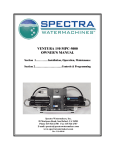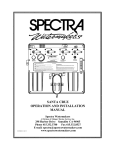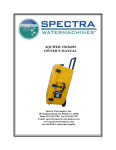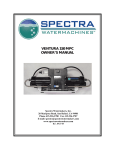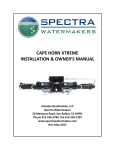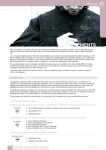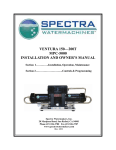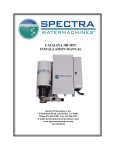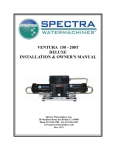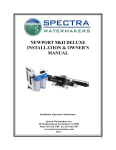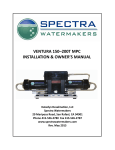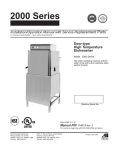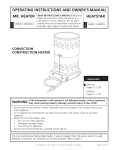Download Cape Horn Extreme INSTALLATION MANUAL
Transcript
Cape Horn Extreme INSTALLATION MANUAL Spectra Watermakers, Inc. 20 Mariposa Road, San Rafael, CA 94901 Phone 415-526-2780 Fax 415-526-2787 E-mail: [email protected] www.spectrawatermakers.com Server/masterdoc/manualscurrent/capehorn 12-18-04 1 Introduction to the Cape Horn The Cape Horn represents the ultimate in reliability and flexibility for racing and cruising yachts. This system is designed to operate in the toughest and most demanding conditions in the world. Prudent seamanship dictates that you maintain enough reserve water to get safely into your next port. The Spectra Intensifier known as the Clark Pump was introduced in 1997 and has continually improved since. It is built of modern non corrosive composites. Pressure relief valve Front View Quick disconnect fitting to facilitate maintenance. Double rubber mounts for to absorb vibration Primary feed pump inlet module. Includes the feed pump, cooling fan, charcoal filter for the flushing system, manual flush valve, service valve and service port . Compact and streamlined plumbing. Cooling fan is included for long life. Local control switch for maintenance. Secondary feed pump module. Includes the feed pump, cooling fan And 5 micron filter. Local control switch for maintenance. 2 Getting Started Unpack the system and inspect it to make sure that it has not been damaged in shipment. Refer to the shipping list for your system to make sure you have received all of the components listed. Do not discard any packaging until you have found and identified all of the parts. The small installation parts are listed on the kit list. Warning! We will not be held responsible for shortages and or freight damage that are not reported within thirty days of the ship date. Study the system layout diagram, component photos and descriptions before beginning your installation. This will assist you in understanding the function of each component. Layout the system. Before starting the installation identify the location where each module and component will be placed. Insure that there is proper clearance around the components for removal of filters and system service. Also check to make sure you have adequate tubing and hose before starting so additional parts may be ordered. Cape Horn Shipping List • High Pressure Clark Pump and a 40” Reverse Osmosis Membrane Module. • Feed pump inlet module with fresh water flush system. • Feed pump module with 5 micron filter housing. • Accumulator Tank • Seawater strainer • Monitor Gauge panel • Installation Fittings Kit • Service Hose kit • Hand held Salinity monitor • 5/8”(14.75mm) Hose • 1/4 product tubing (50’) 3 Brine Discharge thru hull place above waterline or tee brine into another visible drain. Cape Horn Plumbing Layout Plastic fittings should have 3-4 wraps of Teflon tape and will thread almost all the way in. Leave the first pipe thread uncoated. Avoid getting dirt or debris in the system during assembly. Avoid tight bends and elbows. Secure piping away from moving objects and protect from chafe. Accumulator, Factory precharged. Install and plumb as shown. Fresh water flush inlet to charcoal filter. Plumb to fresh water system. discharge Inlet pump modules. Mount vertically as low as practical, no more than 4’ (1.1 M) above waterline and not over electrical equipment. Leave clearance below for filter change. 5 micron filter. Do not mount over electrical equipment. Leave clearance below for filter change. inlet Seawater inlet from a low bubble free intake. System needs a clear flow away from head discharge. Feel Free to Consult Factory Regarding your application. 4 Product Water and Pressure Gauge Tube Installation Sampling Tap for testing the product water or for service procedures. Put enough tube on this port to reach your service (pickling) container. Product to tank. Route the product water from the valve into the top of the tank. Install a tee in the water fill or tap a pipe thread into an inspection port. DO NOT! feed into a vent line, manifold or the bottom of the tank. Make sure that there is no restriction in this piping. Product sampling valve. Mount using the supplied plastic straps as shown. Note: the handle is pointing in the direction of the flow. Pressure Gauge Use accumulator port to connect the pressure gauge. Tubing must be pressure rated to 150 PSI (10 BAR) Product Flow meter Plastic fittings should have 3-4 wraps of Teflon tape and will thread almost all the way in. Leave the first pipe thread uncoated. Avoid getting dirt or debris in the system during assembly. Secure piping away from moving objects and protect from chafe. Exercise care not to cross thread the fittings. See the tube assembly instructions next page. Back view of instrument panel. Product Water Flow Product Ports are located here Product fitting 5 Remove one of the product port plugs (from either end) and thread in the product fitting with Teflon tape sealant. Body O-ring Spacer Grab Ring Nut Step 1: Tubing Dissemble fitting components 1/2" max Step 2: Install the Nut first then use the bevelled side of the Spacer to push the Grab Ring onto the tube no more than 1/2". Slip the O-ring over the tube to hold the Spacer in place. If the Grab Ring is pushed too far, trim back the tube so about 1/4" of tube extends past the O-ring. Step 3: Gently fit the tube into the body and loosely thread on the nut. Step 4: Push the tube into the body until it bottoms out then hand tighten the nut. DO NOT OVER TIGHTEN! 1/4" Tube Fitting Assembly 6 Cape Horn Wiring Diagram Route a heavy pair of wires from the main DC electrical panel to the Feed Pump location. Connectors to the terminal block. Seal connectors. The switch located near the feed pump is pre-wired. Voltage drop will impair performance of the system. Cooling fans Main Electrical Panel Positive buss Feed Pumps 15 amp breakers 12VDC 7 amp 24VDC Feed Pump wiring, Red is Positive Black is Ground. Negtive buss + _ Cooling Fan are connected parallel with the Feed pump. Same color code. To battery, #8 gauge or larger Wire Size Guide for 12V Protect with 15 Amp Fuse or Circuit Breaker # 10 Gauge (6mm) to 15 feet (4.5M) # 8 Gauge (10 mm) to 25 feet (7.5M) #6 Gauge (16mm) to 35 feet (10.6M) Wire Size Guide for 24V Protect with 7 Amp Fuse or Circuit Breaker #12 Gauge(4mm) to 10 feet (3M) #10 Gauge (6mm) to 25 feet (7.6M) #8 Gauge (10mm) to 35 feet (10.6M) 7 New System Start-Up and Testing Avoid running the system if the vessel is in contaminated water, such as in a harbor or canal. The system should be fully run tested before leaving port. If the location or weather prevents proper testing refer to the section “Dry Testing.” Warning! Damage may occur if the purge sequence is bypassed and the membrane is pressurized with storage chemical in it. 1. First Check That: • • • • • Thru-hull inlet valve is open and the Brine discharge valve is open. All of your hose connections are tight. You remove the green tag with the spacer under the pressre relief valve. Open the pressre relief valve 1/2 turn. The sampling valve is set to the sample position. Remove Tag and Washer! Open 1/2 Turn to Purge Chemicals! 2. Turn on one of the feed water pumps. Check that it is primed by inspecting the brine discharge. Turn off and then turn on the other pump to prime. 3. Run the system using both pumps, without pressure for 20 minutes to purge the storage chemicals. The system should have an open flow pressure on the gauge of about 30 PSI (2 Bar) 4. Close the pressure relief valve. The pressure should rise to 80-90 PSI (5.5-6.5Bar) and after several minutes start making water. If the vessel is located in brackish or fresh water the pressure will be lower 5. Allow the system to run for 5-10 minutes and then test the product with your hand held salinity tester. If the product is below 750 PPM it is considered potable and may be diverted to the tank. 8 Dry Testing With Artificial Ocean If it is not possible to test run the system with the boat in the water testing may be accomplished with an artificial ocean. Purchase enough aquarium salts to make 5 gallons (20 liters) of salt water. Make sure that the domestic water system is powered up and that there is water in the tank. Confirm that the Charcoal filter is installed in the Fresh water flush module and that the domestic water line had been installed and all valves are open. 1. 2. 3. 4. 5. 5. Open Pressure Relief Valve on the Clark Pump. Remove the green tag and spacer! Close the yellow service valve on the inlet module. This will be the center location. Open the grey fresh water flush valve. Start the feed pump and let it run 20 minutes to purge the storage chemical. Stop the feed pump Hook up your Inlet and Brine discharge service hoses per the photo and route them into the 5 gallon (20 Liter) container. Turn your Product sample valve to the sample position. Route the product output into the bucket. 6. Restart the feed pump and fill the bucket with fresh water from the brine discharge. Stop the pump and close the fresh water flush valve. 7. Rotate the yellow service valve to the service position. 8. Mix the salt to the proper proportion or use an aquarium hydrometer to adjust the salinity level. 9. Start the feed pump, allow to prime and then close the pressure relief valve. The system should build pressure and after several minutes start making water. 10. Run the system under pressure and check for proper operation and leaks. After testing the system stop the feed pump and replace the brine discharge hose. Restart and drain the bucket. You can now store the system by using the above procedure for adding fresh water to the bucket and using the Storage procedure. If the system is to continue to be commissioned performing a fresh water flush will hold the system for 4-5 days. Valves in flush position Valves in service position Inlet service hose connected. Connecting the Brine Discharge service hose. 9 System Operation Normal operation If the system has been pickled or stored use the New system startup procedure. 1. Check to see that the inlet seacock is open. 2. Turn the product valve to the “Sample” position. 3. Start the feed pumps and check for flow by inspecting the brine discharge or checking for pressure on your analog gauge. If there is no flow open the pressure relief valve on the Clark pump and bleed the air out of the feed pumps by running them one at a time. 4. After five minutes check the product water with your hand held salinity tester. If it is good you may divert it into your tank. 5. Run the system until you have filled your tank or have made enough to meet your requirements for several days. 6. Turn on the fresh water flush valve and close the service valve. 7. Flush for 2 1/2 minutes or until the pressure drops on the gauge indicating that the membrane is flooded with fresh water. Stop the feed pump. 8. Return the service valve and the flush valve to their run positions. 9. The system may be run with only one feed pump in extremely cold water conditions or if highly efficient operation is desired. Water quality will suffer somewhat. You may now leave the system unattended for up to five days without further attention We recommend operating the system for longer periods and effecting a FW flush than running the machine every day and not flushing the system, Remember that you need to run the system almost a half hour to make the flushing water. You may notice that the system output is higher while charging your batteries as the machine is voltage sensitive. Inlet Module with valves in the Inlet Module with valves in the normal “Run” Position. “flush” Position. Open Closed Closed Open 10 Long Term Storage Procedures Watermakers are best run continuously. When not in use, biological growth in the membrane is the leading cause of membrane fouling. A warm environment will cause more growth than a cold environment. The fresh water flush system will greatly reduce biological growth but may not stop it completely in certain conditions. If an optional “Zeta Guard” or Z-Brane water treatment system is installed in the system, then three to five day flushing intervals will maintain the system as long as fresh water is provided and the charcoal filter maintained. System Storage or “Pickling” If the system is to be left unused for more than five days, perform the following storage procedure. The procedure introduces a chemical compound into the system that prevents biological growth. This procedure requires de-chlorinated water which can be made with the Spectra’s charcoal filter. Charcoal filters last a maximum of 6 months once wetted. Spectra SC-1 a special storage compound used by the US Navy. It is formulated to be compatible with the modern engineering plastics and composites in the Spectra pumps. Do not use any substitute except propylene Glycol. If you wish to use glycol for storagefollow the winterizing instructions. SC-1 Storage Compound has to be mixed at a ratio of 1 Spectra container to 3 gallons (12L) of fresh water to have the proper solution for short term storage (under two months use 1/2 of a container) Caution! Avoid contact with skin, eyes, or lungs with the storage chemical. 11 Storage Procedure 1. Perform a fresh water flush as described in the normal operation section. Shut down the feed pump but leave the valves in the flush position. 2. Remove the quick disconnect fitting from the brine discharge outlet of the Clark pump, and replace with a quick disconnect from your service kit, fitted to a hose, and lead the hose to a 5 gallon bucket or container. 3. Start and run the feed pump until you have one gallon of fresh water in the bucket. 4. Mix 1 container of SC-1 storage compound with the water in the bucket. 5. Connect the service hose, using the garden hose barb fitting from your service kit, to the service port of the fresh water flush module. Lead the hose into the bucket. Turn the service valve on the fresh water flush module 180°, so the intake is now coming from the bucket. 6. Make sure the pressure relief valve on the Clark pump is Open (unpressurized) by turning 1/2 turn counterclockwise 7. Turn on the feed pump. Circulate the storage chemical in the system for approximately 10 minutes. Turn off the feed pump when finished. Clean Up: Remove the quick disconnect from the Clark pump brine discharge, and replace the original hose that leads to the thru-hull. You may at this point, if you choose to, pump the bucket dry by using the feed pump switch. Stop when the bucket is empty. Turn the service valve 180° back to its original position, and remove the service hose. Close the seacock and drain and clean the strainer and any filters in the system. Reassemble dry. 12 Winterizing 1. Close yellow service valve, open the Grey flush valve and run the feed pump 4 minutes to effect a complete fresh water flush. Shut the pump and flush valve off. 2. Connect your inlet service hose and your brine discharge service hose place them in your service container or bucket. 3. Turn the service valve to the service position. 4. Pour 2 gallon (8L) of Propylene Glycol in the bucket. 5. Make sure that the pressure relief valve is open (un-pressurized). 6. Turn on the feed pump and re-circulate the chemical for 20 minutes. 7. Stop the pump. Reconnect the brine discharge hose. Restart the pump until the bucket is empty. 8. Close the seawater intake and the service valve. Drain the strainer the hose leading to the inlet module. Disconnect the product tubing and blow any residual water out of the tubing with compressed air. Valves in flush position Valves in service position Open the pressure relief valve Connecting brine discharge hose 13 Maintenance General Periodically inspect the entire system for leakage and chafe on the tubing and hoses. Repair any leaks you find as soon as practical. Some crystal formation around the Clark pump blocks is normal. Wipe down any salt encrusted areas with a damp cloth. The Seawater Strainer The sea water strainer’s stainless steel element should be inspected, removed, and cleaned as needed. Be careful to ensure that the thru-hull is closed before disassembly and the gasket is in place before reassembly. . When the system is put into storage, remove, rinse, and reassemble dry to impede corrosion. Check frequently during operation. The Prefilter • • • Service the prefilter on a regular basis. The pressure will drop on the remote gauge when the filter becomes dirty. Extremely dirty filters will harm system performance and may cause the feed pump to cycle on the high pressure switch. To service the filters shut off the service valve open the housing, discard the old filter, Clean out the housing bowl, reassemble the housing with new 5 micron filter element. Leave dry until next startup. Use only Spectra approved filters or you may void your warranty. The filters may be cleaned several times with a soft brush and water in a bucket. Occasionally, lightly lube the filter housing O-ring with silicone grease. Oil Water Separator (Optional) To install Oil Water Separator capability install the additional filter housing with its oil removal filter upstream of the 5 micron filter. Service at the same time as the 5 micron filter. The Charcoal Fresh Water Flush Filter • Replace the charcoal filter element at least every 6 months! This filter protects the membrane by removing chorine from the fresh flush water. Use only a Spectra replacement! The Feed Pump and Clark Pump The feed water pumps and the Clark pump require no routine maintenance except inspection for leaks. Tighten any hose clamps or fittings the show signs or leakage. The HP fittings threaded into the Clark pump are o-ring seals with a straight thread. These should never leak and should never be over tightened. If one of the tube nuts starts to leak it can be usthreaded, sealed with a bit of silicone grease or silicone seal and with two wrenches tightened with two wrenches very tight! 14 The Membranes • The membranes need to be cleaned only when they have lost up to 15% of their capacity due to fouling or the product quality degrades. The leading cause of fouling is from biological growth that occurs when the system is left unused without flushing or pickling. Fouling from mineral scaling can happen during operation under certain sea water conditions, and from rust. Monitor the product salinity and feed pressure for higher than normal readings for the conditions. Other conditions can cause high pressure such as cold feed water or clogged filters. Low product flow is usually due to low voltage, damaged feed pump or Clark pump. Look for all other causes before cleaning the membrane. Membrane life can be shortened by excessive cleaning. • There are two types of cleaners: acid and alkaline. The acid cleaner (SC-3) will remove mineral scaling. The alkaline cleaner (SC-2) is used to remove biological by-products, oil, and dirt particles that get past the prefilters. If membrane performance is reduced and they have not been pickled recently, cleaning with both chemicals is recommended. The acid cleaner should be used first. If the membrane fails to respond to both cleanings, this is an indication of another problem with the system, or that it is time to replace the membrane. Contact Spectra Watermakers before removing a membrane. Membrane Cleaning For normal cleaning, the SC-3 Acid Cleaning Compound is used first, then the SC-2 Alkaline Cleaning Compound. If known bio-fouling is present, the SC-2 may be used first. Using hot water if possible, up to 120° (45C) is recommended as it greatly enhances the ability of the cleaners to do their jobs. If the history of the system is unknown or has been left “unpickled” for an extended length of time and biological growth is present, it is recommended that the system is cleaned with SC-2, using an alternate source of unchlorinated fresh water before the system is run under pressure. A simple test can be performed to see if biological growth has occurred. Before running the system, remove the prefilters and examine their condition If the housings are full of smelly discolored water, the system was not properly stored. Install clean prefilters if they were bad. Next check the membrane. Detach the brine discharge hose and lead to a bucket. Open the pressure relief valve one turn, and manually run the system for 30 seconds. Examine the brine water: if it’s discolored and smells bad, perform an SC-2 cleaning with an alternate source of unchlorinated water before running the system pressurized. If the brine is fairly clean, the system can be purged, run normally, and checked for performance. Clean the membranes only if performance is reduced. Heating the water is preferable. One way to do this is to find a camp stove and use a large stainless steel pot to heat the solution in. The cleaning solution throughout the system will heat as it circulates in and out of the pot. An alternative is to heat the one or two gallons of initial water to 120° on the main stove before mixing in the cleaner and circulating it into the system. Periodically stop and reheat the solution. Perform the cleaning procedures while the ship is in acceptable sea water for purging and testing. 15 Note: Procedures are the same for the SC-2 and SC-3 cleaners A Spectra Cleaning Compound (SC-2 or SC-3) must be mixed with fresh water at a ratio of 1 container of compound to 3 gallons (12L) of unchlorinated water to have the proper solution. An average of two gallons (8L) of water is already present inside a 150 system . This water has to be figured into the mixture. A 150 system will use 1 container of compound, Cleaning Procedure: 1. Close the service valve, open the flush valve and run the feed pump for 4 minutes to flush the system. Stop the pump and close the flush valve. 2. Connect your inlet service hose and the brine discharge service hose. Open the flush valve and start the pump until you get a gallon (4L) of water in the bucket. 3. Turn the service valve to the service position. 4. Make sure that the Pressure relief valve is open (un-pressurized). 5. Mix the cleaning chemical in the bucket. 6. Start the system and circulate the chemical through the system for the required time. 7. Stop the pump, replace the brine discharge hose and start the pump until the bucket is empty. Stop the pump and rotate the service valve back to the run position. Restart the pump and run for 20 minutes to flush the chemicals out of the system. (Do Not Close the Pressure Relief Valve!) 8. The system may now be restarted to make water, flushed or stored. Valves in flush position Open the pressure relief valve . Valves in service position Connecting brine discharge hose 16 Suggested Spares Short term trips, weekends etc. We suggest a basic cruise kit A. Kit consists of 6 ea, 5 micron filters and two SC-1 storage chemicals. 2 to 6 months at a time. Two basic cruise kits, One each replacement charcoal filter. One replacement feed pump head. Longer than 6 months, Additional filters, offshore cruising kit consisting of Clark pump seals, O-rings, tools and membrane cleaning chemicals. One replacement strainer screen, O-ring for strainer screen, O-rings for filter housing Part Number Spectra Watermakers parts list: SC-1 STORAGE CHEMICAL SC-2 CLEANER SC-3 CLEANER BASIC CRUISE A 5 MIC FILTER CHARCOAL FILTER 6” STRAINER SCREEN OIL/WATER FILTER FEED PUMP HEAD 6” STRAINER O-RING FILTER HOUSING O-RING OFF SHORE KIT 20” MEMBRANE P/N FT-CHE-SC1 FT-CHE-SC2 FT-CHE-SC3 KIT-BCK-A FT-FTC-5 FT-FTC-CC FT-STN-6S FT-FTC-OW SO-STN-6SS SO-FHS-10H KIT-OFFSH FT-MB-20 17 Troubleshooting Deluxe Systems Symptom Feed pump runs but no pressure. Cause Feed pump air locked Pressure relief valve open Feed Pump starts but shuts down on Prefilter excessively clogged. high pressure. Closed valve or blockage in flow. Remedy Open pressure relief valve to bleed the air then close to start. Close valve. Change filter. Check flow path for closed valve or kink in hose. Low Water production High amperage. High Feed pressre Strainer or prefilter clogged. Service prefilter and strainer. Low Water production, Low pressure. Pressure Relief valve partially open. Worn Pump head, Close Valve Check flow should be 1.4 GPM Replace Pump Head. Water production normal High feed pressure high amperage. Cold seawater temperature Fouled membrane Normal condition Clean membrane. Water production normal Lower pressure lower amperage Warm Sea Water or Brackish water. Normal Condition. Asymmetrical pressure and flow readings between pump shifts Check valve leaking failed annular ring. Shaft Seal leaking. Contact Dealer or see the Clark Pump repair manual. 18 5/8 Quick Disc. Hose Barb PL-QDC-HB5/8 3/8 NPT Quick Disc. Body PL-QDC-BD3/8 3/8NPT Nylon Hex Plug PL-HP-3/8 1/8"FPTX1/4"Tube Fitting Ell. PL-FTE-1/8X1/4P Pressure Vessel Ring FT-PV-ER Pressure Vessel End Cap FT-PV-EP 3/8"NPTX1/2"Tube SS Fitt.. St. PL-MTS-3/8X1/2S Connector O-ring SO-HPP-CT 40” High Pressure Vessel FT-PV-40 1/2” High Pressure Tube PL-NLT-1/2HP Low Pressure Filter Housing (Whole Assembly) FT-FTH-10L 3/4"MPT X 5/8"HB X 5/8" HB PL-TEE-3/4M5/8B #8 Hose Clamp PL-CLP-8SS 3/4”NPT X 5/8” Hose Barb Ell PL-HBE-3/4X5/8 Cooling Fan Kit KIT-FK-12, 24 Heat Sink EL-FP-FPHS 5 Micron Filter Cartridge FT-FTC-5 3/8”NPT X 5/8” Hose Barb Ell PL-HBE-3/8X5/8 Ventura Intake Module FM-VT-ITM Feed Pump Assembly (Whole Pump With Heat Sink) KIT-FP-SF12, 24 Pump Head Assembly With Pressure Switch PL-PMP-SFPH Sea Strainer (Whole Assembly) FT-STN-5 Strainer Seal SO-STN-5SS Strainer Screen FT-STN-5S 19 1/2” Tube Fitting Hex Nut PL-HWR-1/2HN 1/2” SS. Ferrule PL-HWR-1/2FR 3/4”-16 Straight Fitting O-ring SO-FT-STF Connector O-ring SO-HPP-CT 1/2” High Pressure Tube PL-NLT-1/2HP 3/8 NPT Quick Disc. Body PL-QDC-BD3/8 Front View 5/8 Quick Disc. Hose Barb PL-QDC-HB5/8 Plate Bracket End Cap FM-PVB-PBE 3/4”NPT X 1/2” Hose Barb Elbow PL-HBE-3/4X1/2 3/4”NPTX3/4”FPT PVC Valve PL-VLV-3/4PVC Rear View Plate Bracket FM-PVB-PB Rubber Mount HD-RBP-RM Nylon Spacer HD-SPN-MKINS Clear Filter Housing (Bowl & Cap) FT-FTH-10L Filter Housing Seal SO-FHS-10H Charcoal Filter Cartridge FT-FTC-CC 3/4” 3-Way Valve PL-VLV-3W3/4 3/4”NPTX5/8” Hose Barb PL-HBS-3/4X5/8 20 3/4” Clamp PL-CLP-3/4CAR !/4” 3-Way Valve PL-VLV-3W1/4 1/4”NPTX1/4”Tube Fitting PL-MTS-1/4X1/4P 1/2NPTX5/8 Hose Barb PL-HBS-1/2X5/8 1/4”NPTX1/4” Tube Fitting El. PL-MTE-1/4X1/4P Accumulator Tank PL-ACC-TK 1/8”NPTX1/4”Tube Fitting El PL-MTE-1/8X1/4P Pressure Guage PL-PSG-LP2.5 Spectra Panel FM-KIT-MP Product Flow Meter PL-FMT-10 1/4”NPTX1/4”Tube Fitting PL-MTS-1/4X1/4P 1/2NPT X 1/4FPT Bushing Reducer PL-BSH-1/2X1/4N 1/2” NPT Nipple PL-NP-1/2N Pressure Vessel Ring FT-PV-ER 1/4”FPTX1/4” Tube Fitting El PL-FTE-1/4X1/4P 1/2” Female Tee PL-TEE-1/2FN 3/8”NPTX1/2”Tube Fitting SS. PL-MTS-3/8X1/2S Pressure Vessel End Cap FT-PV-EP 1/8” NPT Nipple PL-NP-1/8N 1/8”FPTX1/4”Tube Fitting El PL-FTE-1/8X1/4P 21 End block B HP-TB-VEB-B Valve block HP-TB-VB End block A Composite cylinder and base HP-TB-VEB-A Brine out HP-CYL-CCA Pressure relief valve HP-TB-BV Center block HP-CB-CB7,10,15,20 Feed in Stainless steel tube HP-CYL-SST Cylinder ring HP-CYL-R End Cap Clark Pump Front View HP-CYL-EC End block A Valve block End block B Reset button Composite cylinder and base Not on all unitsHP-TB-RSBT Alternate brine out High pressure in Test port Center block High pressure out Stainless steel tube Cylinder ring End cap Clark Pump Back View 22 5/16"-3 1/4" SS AH Bolts HD-CPS-5/16X3 Spool Assembly Exploded View Spool End Spool Seal Quad Ring Seal Spool Center Quad Ring Seal Spool Seal Relief Valve O-Ring Spool End SO-HPP-RV Annular Rings HP-TB-AR Spool Assembly KIT-HP-10VSA Relief Valve HP-TB-BV Annular Ring O-Rings Mount inside Valve Block SO-HPP-AR Valve Block 5/16"- 2 3/4" SS A.H. bolts Reset button and O-ring End block B Piston O-ring SO-HPP-SP, PS20 HD-CPS-5/162.75 Spool piston HP-TB-VSP,VSP20 HP-TB-SR Spacer ring Valve block SO-HPP-VB Valve bore O-ring Valve bore O-ring Spacer ring Spool piston Brine port O-ring End block A SO-HPP-VP Valve spool Pilot port O-rings Piston O-ring SO-HPP-PLP Reversing Valve End Blocks 23 Valve port seals SO-HPP-VP Pilot valve port seals SO-HPP-PLP Piston rod HP-CYL-3/4R,7/8R,1R Center block cylinder O-rings SO-HPP-ECCB Pilot spool O-rings (4) Mount inside block SO-HPP-PV HP-CB-PVS Pilot spool HP-CB-PPS Pilot valve pin SO-HPP-PS Pin seal O-rings Pilot orifice HP-CB-PO HP-CB-PVPS Pin seals HP-CB-PVCR Clip rings Center block Rod lip seals Mount inside block SO-HPP-PR7, PR10,PR15 Feed in Check valve port O-rings SO-HPP-CVP Check valve assembly Piston to rod O-rings (2) Inside pistons Glass rod models only Center Block Check valve SO-HPP-CVS O-ring Check valve seat HP-CB-CVS Check valve poppet HP-CB-CV Check valve spring Check valve washer Check valve retainer HP-CB-CVR 24 S.S compression fittings 1/2" SS tube Piston with seal HP-CYL-SST HP-CYL-PT PL-MTS-3/8X1/2S Composite cylinder and base HP-CYL-CCA End cap O-ring Cylinder end cap SO-HPP-ECCB HP-CYL-EC Cylinder Ring HP-CYL-R Cylinder Assembly Piston with seal S.S compression fittings 1/2" SS tube End plug O-ring End plug Composite cylinder and base Cylinder Assembly Early Models 25


























